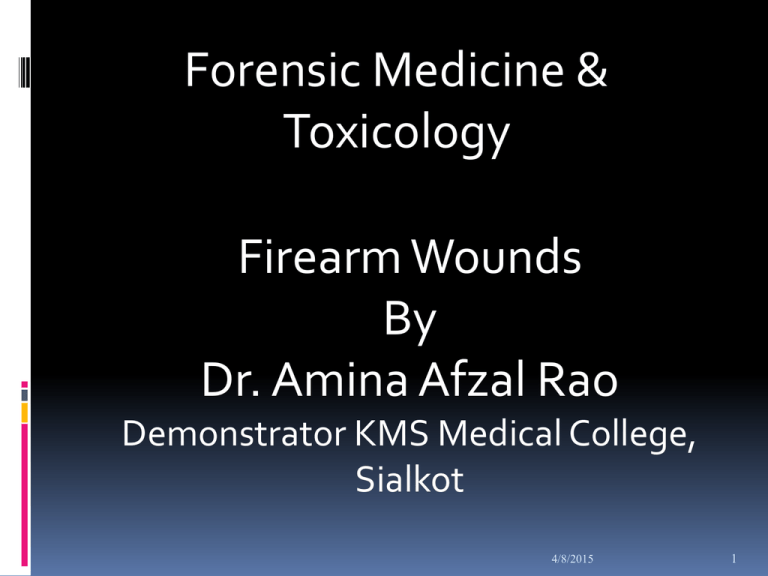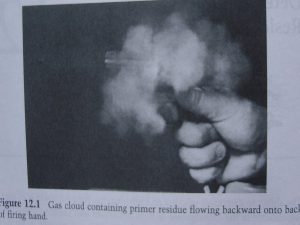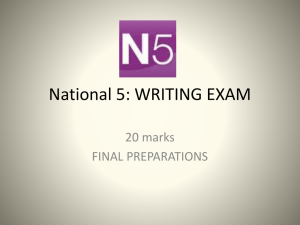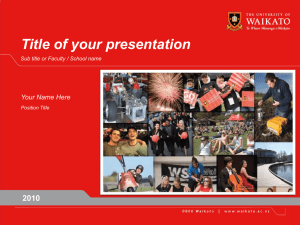fire-arm - kmsmc.edu.pk
advertisement

Forensic Medicine & Toxicology Firearm Wounds By Dr. Amina Afzal Rao Demonstrator KMS Medical College, Sialkot 4/8/2015 1 Firearm Wounds By Dr. Arif Rasheed Malik Associate Professor & Head Department of Forensic Medicine & Toxicology, SIMS, Lahore 4/8/2015 2 Weapons are fashion accessories and easily available 4/8/2015 3 Firearm “ An instrument or device with which it is possible to propel a projectile by means of the expansive force of the gases generated by the combustion of an explosive substance “ FIREARM WOUNDS “ Firearm wounding is a special form of trauma producing a breech through the body of a person by a bullet or shot charge “ Principles & Practice of Forensic Medicine by Nasib R. Awan 4/8/2015 4 History of Firearms Firearms came to Europe from China To produce an efficient firearm, there are three basic criteria to be met. Weapon should be capable of causing substantial damage It should be reliable & convenient to use It should be reasonably accurate Reverend Alexander John Forsythe, in 1807, living near Aberdeen, Scotland, held the first patent for a percussion ignition system.. 4/8/2015 5 History of Projectile weaponry Earliest weapons: bow and arrow, crossbow, simple catapult to huge ballistics / trebuchet Gunpowder developed in china 1500 yrs ago; came to Europe and from 14th century used as weapon Gunpowder= Charcoal, Saltpetre (Potassium Nitrite), Sulphur Earliest guns were cannons, front then breech loading Early guns flintlock muzzle loading with 3 parts “lock, stock and barrel” 4/8/2015 6 Assault rifles AK-47 Assault rifle Developed: 1974 Mikael Kalashnikov Caliber: 5.45mm Magazine capacity: 30 Loaded weight: 3,600g Killing range: 1,350m 4/8/2015 7 Ballistics “ Knowledge of physical forces acting on the projectile & missile “ by Nasib R. Awan Interior Ballistics Exterior Ballistics Terminal / Wound Ballistics 4/8/2015 8 Ballistics T H E O R E T I C A L Interior ballistics Wound ballistics Exterior ballistics P R A C T I C A L Clear Concept 4/8/2015 9 INTERIOR BALLISTICS Knowledge of the forces responsible for propulsion of projectile within the bore of the barrel till the end of the projectile. 4/8/2015 10 Understanding pre-requires knowledge of:- 1Missile design & cycle of fire. 2Ammunition design. Missile design & cycle of fire Missile design:a- Portion containing mechanical device (not important). b- Barrel for jetting of the projectile (Important because it has relation to WOUND BALLISTICS). 4/8/2015 11 Firearm Design Grip Action Barrel Barrel Grip or But Stock Action 4/8/2015 12 Firearms Luger 9mm Colt 45 9 mm Thompson 5.7 mm 4/8/2015 13 Classification of Firearms Classified on the basis of Barrel Barrel Steel tube for jetting of the projectile. Two ends --Breach & Muzzle end Bore Internal diameter of the barrel. May be SMOOTH or RIFLED 4/8/2015 14 Classification of Firearms Smooth Bored Rifled Choked Short Barrel Non choked Long Barrel Barrel Rifling 4/8/2015 15 Choking of Smooth bore Firearm 18.80 mm 18.40 mm Cylindrical portion 4/8/2015 16 TYPES OF CHOKING OF BARREL OF SHOT GUN CHOKE FULL CHOKE MODIFIED CHOKE IMPROVED CYLINDER CYLINDER PERCENTAGE OF PELLETS AT 40 YARDS IN 30 INCH CIRCLE 65 - 75 45 - 55 35 - 45 25 - 35 4/8/2015 17 Cycle of fire:- Three stages: i- Cartridge feeding and chambering. ii- Striking of fire iii- Extraction of fire cartridge. 4/8/2015 18 Ammunition Design Projectile consists of:- Cartridge Case Primer Powder charge (Black or Smokeless) Plastic Wad Shot charge (Bullet or Lead shots) C A R T R I D G E B U L L E T 4/8/2015 19 CARTRIDGE CASE Function: expands and seals chamber against rearward escape of gases. Composition: usually brass (70% copper 30% zinc); also plastic and paper in shotgun shell tubes. Shape: (a) straight ("always" pistol ammunition) (b) bottleneck ("always" rifle ammunition) (c) tapered ("obsolete"). Extractor flange: configuration at base; rimmed, semi-rimmed, rimless ,belted, rebated. Headstamp: manufacturers identifiction imprinted or embossed 4/8/2015 on cartridge case. 20 Cartridge Case I. II. III. IV. V. VI. Cartridge cases (outer covering of the cartridge) are made up of Cardboard & plastic. Bullet cases are made of brass (70% copper and 30% zinc). A few have a nickel coating. Primer cases are of similar composition (Cu-Zn). Bullet cores are most often lead and antimony, with a very few having a ferrous alloy core. Bullet jackets are usually brass (90% copper with 10% zinc), but some are a ferrous alloy and some are aluminum. Some bullet coatings may also contain nickel (Ravreby, 1982) 4/8/2015 21 FUNCTIONS OF CARTRIDGE CASE CONTAINS AND KEEPS THE INNER CONTENTS IN POSITION PREVENTS THE BACK ESCAPE OF GASES PROTECTION TO THE CONTENTS TYPES OF CARTRIDGE CASES Rimmed, Semi rimmed, Rimless, Rebated, Belted CSAELESS CARTRIDGE 4/8/2015 22 Primer The major primer elements are Lead styphnate(Pb), Barium nitrate (Ba), or a Antimony sulphide(Sb). Usually, all three are present. Less common elements include Aluminum (Al), Sulfur (S), Tin (Sn), Calcium (Ca), Potassium (K), Chlorine (Cl), or Silicon (Si). Primer elements may be easier to detect in residues because they do not get as hot as the powder, and compounds (not just elements) may be detectable. (Tassa et al, 1982b) 4/8/2015 23 Function: explodes on compression igniting the propellant. Location: (a) centrefire. Centrally placed primer assembly comprising primer cup (struck by firing pin), primer, anvil with flash holes. Boxer design (USA) or Berdan design (Europe). (b) rimfire. No primer assembly. Primer spun into rim of cartridge case (rim struck by firing pin) and in contact with propellant. 4/8/2015 24 Various types of Ammunition 4/8/2015 25 Powder Charge Modern gunpowder, or "smokeless" powder, can contain up to 23 organic compounds (FBI study) Nitrocellulose is virtually always present, along with other compounds containing nitrate or nitrogen. One of these compounds, diphenylamine (used as a stabilizer in the powder), can be detected using reagents containing sulfuric acid. (Maloney et al, 1982). Modern gun powders are also described as "single-base" when the basic ingredient is nitrocellulose and as "doublebase" when there is additionally 1 to 40% nitroglycerine added. If nitroguanidine it is “Triple – base”. Hardy and Chera (1979) describe a method to differentiate them using a mass spectrometer . 4/8/2015 26 BLACK GUN POWDER POTASSIUM NITRATE OR SALT PETER 75% CHARCOAL SULPHUR 15% 10% Charcoal is the fuel, potassium nitrate the oxygen supplier gives the mixture more density and makes it more readily ignitable 4/8/2015 27 PROPELLANT Function: burns to produce large volumes of gases under pressure. Shape: sheets of smokeless powder cut into disc, flake or cylinder shapes. Alternatively produced as ball and flattened ball smokeless powder (Winchester) which may be coated with silver-black graphite. 4/8/2015 28 Chain of Events Strike Primer ignites Powder charge burns Temperature increases Gases produce Chamber pressure increases Bullet/Shot charge moves Exit of bullet Chamber pressure zero Gases produced: Carbon dioxide, Carbon monoxide Nitrogen, Sulphurated hydrogen 4/8/2015 29 CHAMBER PRESSURE:i- Revolver:- 4 tons ii- Pistol:6 tons iii-Rifle:- 20 tons Bullet:Forward & rotational motion. Shot charge:- Forward movement. 4/8/2015 30 Exterior Ballistics “ Knowledge of forces acting on the shot while it leaves the barrel till it reaches the target “ Interactions of forces:1- Forces originating from the bullet motion a- Velocity:- i- Forward (Rate of motion (speed) and Direction ii- Rotational :- It varies (length of the barrel) b- Velocity of bullet at the muzzle end for various firearms:i- Revolver:- 600 – 900ft/sec ii- Pistol:- 1200 – 1440 ft/sec iii- Rifle:2000 – 3500 ft/sec 2- Forces present in the medium a- Air resistance b- Gravity 4/8/2015 31 Forces originating from the projectile Velocity 1- Speed or Rate of motion also called Muzzle velocity Rifles upto 2000 – 3000 fps 2- Direction of motion Forward motion Also Rotational motion in bullets Bullets do not typically follow a straight line to the target. Rotational due to rifling forces are in effect that keep the bullet off a straight axis 4/8/2015 of flight. 32 DEFINITIONS YAW: is the oscillation around the long axix of the bullet. PRECESSION: is a circular Yawabout the center of gravity which takes the shape of a decreasing spiral. Nutation: is a rotational movement in a small circle which forms a rosette pattern like a spinning top. 4/8/2015 33 Forces present in the medium Projectile Follows.. 1- Air resistance 2- Gravity Curved path Trajectory of bullet 4/8/2015 34 Trajectory of bullet 4/8/2015 35 Tail wag phenomenon Tail wag Inside barrel projectile is supported by walls of barrel Entering new medium loses Initial Terminal tail wag balance due to air resistance & force of gravity tail wag Regains balance after covering some distance Intermediate tail wag 4/8/2015 36 Bullet through a glass Intermediate tail wag Secondary misslies 4/8/2015 37 Tail wag phenomenon For pistol up to 60 yards For Rifle up to 200 yards Medicolegal importance Atypical firearm entry wounds 4/8/2015 38 Terminal / Wound Ballistics “ It is concerned with the effect of bullet on the target at impact until it comes to rest “ by Naseeb R. Awan Mechanism of Wound production Laceration & Crushing Shock waves Cavitation 4/8/2015 39 Mechanism of Wound production INTERACTION BETWEEN THE FIRE – BLAST AND PART STRUCK FORCES IN THE FIRE - BLAST FACTORS IN THE PART STRUCK PROJECTILE & ITS RESISTANCE OF THE TISSUE DIAMETER DEPENDS UPON SHAPE NATURE, WEIGHT DESIGN & RIGIDITY DENSITY TERMINAL VELOCITY (MOST IMPORTANT) 4/8/2015 40 Laceration & Crushing Kinematics is the science of motion. In gunshot wounds we can use this to determine the extent of injury from the forces and motion involved. Velocity is a key factor to the overall extent of gunshot wounds According to the kinetic energy equation: (kinetic energy = mass/ 2 x velocity2) Doubling the mass doubles the energy, however doubling the velocity quadruples the energy Therefore a small-caliber bullet traveling at high speed can produce a more extensive injury than larger caliber bullet traveling at a lower speed 4/8/2015 41 Laceration & Crushing …. produced by the direct effect of bullet 1- Missile velocity 2- Shape & composition of projectile or Frontal area 3- Angle of impact 4- Flight characteristics as yaw, tumbling & nutation 5- Fragmentation 4/8/2015 42 LOW VELOCITY BULLET a. PART STRUCK SOFT AND ELASTIC TISSUE b. PUSHES & STRETCHES THE SKIN & UNDERLYING TISSUE. c. ROTATES UPON ITS AXIS d. INDENTATION IS PRODUCED e. PERFORATION OF TISSUE f. PASSAGE OF BULLET g. ENERGY OF BULLET RADIATES LATERALLY h. DAMAGE PROPORTIONATE TO DIAMETER OF THE BULLET i. REPRESENTED BY THE PATH OR TRACK OF THE BULLET 4/8/2015 43 SHOCK WAVES DEMONSTRATED ONLY BY HIGH SPEED PHOTOGRAPHY OR RADIOGRAPHY II. IN HIGH VELOCITY BULLETS III. TRACK IS FORCED THROGH SOLID TISSUE. IV. MEDIUM IS COMPRESSED BY MISSILE IN FRONT OF IT V. REGION OF COMPRESSION MOVES AS A SHOCK WAVE OF SPHERICAL FORM, 4800/FT/S VI. CHANGES OF PRESSURE REMAINS FOR A MILLIONTH OF SECOND BUT MAY REACH PEAK VALUE UP TO 100atm. I. VII. So damage at a distance from wound track. VIII. Solid tissues like Muscle, Liver, Spleen & brain are very susceptible. IX. Conducted particularly well along tube filled tubes like arteries & veins to cause damage at a distance. 4/8/2015 44 Shock Waves Shock waves …. generated in tissues by high velocity bullets, greater than 2,500/feet/sec Last only for 15-25 microseconds Are of high energy creating over 1000 lbs/sq inch of pressure Easily rupture gas filled organs 4/8/2015 45 Types of cavitations Temporary: Permanent: High velocity missile Main destructive effect Release of energy, absorbed by the local tissue. Accelerated violently forwards & outwards. Continue to move even after passage of missile. A large cavity is produced (temporary cavity), reaches its maximum size, have sub atmospheric pressure, collapses in a pulsatile fashion and permanent cavity left. Soft tissues pulped, blood vessels disrupted and bone may be shattered. 4/8/2015 46 Cavitation …. created by the bullets travelling at speeds > 1000 ft/sec Size & shape depends upon the capacity of the bullet to disperse energy in the surrounding tissues Tissues are moved forward & laterally away from the bullet Continues for few milliseconds after bullet has passed This creates a cavity which sucks air in from entry & exit wounds & may be 30 times more in diameter than that of the bullet Permanent cavity if exists is much smaller than the temporary cavity 4/8/2015 47 M/L Importance of Wound Ballistics 1- Recognition of Entry & Exit wounds 2- Distance of Fire 3- Direction of fire & Wound track 4- Relative position of weapon/victim & angle of fire 5- Cause of death 6- Manner of death 7- Identification of firearm 4/8/2015 48 Components of a Shot responsible for damage 1- Shot charge (bullet/pallet) 2- Flame & heat 3- Hot explosive gases 4- Smoke 5- Wad 6- Unburnt gun powder 7- Grease from the barrel 4/8/2015 49 All these elements affect: I. Body of the victim as signs & symptoms II. At the place of strike or target produce characteristic changes Result is FIREARM WOUND COMPLEX This has two components: a. Wounding component b. Non – wounding component 4/8/2015 50 Firearm-wound complex has four parts: 1. An entry wound 2. A track with its direction 3. Place of resting of bullet or shot-charge. 4. Exit wound 4/8/2015 51 ENTRY WOUND SINGLE HOLE: SIZE : depends upon skin elasticity, tail wag, explosive blast effect of gases so either proportionate to the diameter of the bullet, SMALLER or much larger having STELLATE SHAPE. SHAPE: depending upon the angle of firearm with the target. Circular, Oval, Elliptical, An elongated furrow. Inverted margins. May be everted. Collar of abrasion: shape depends upon the angle of firearm with the target. 4/8/2015 52 FLAME 4/8/2015 53 BURNING 4/8/2015 54 SMOKE 4/8/2015 55 Carbon particles scattered on HISTOLOGICAL examination 4/8/2015 56 Burning: Few inches in case of revolver & one foot in case of a Shotgun by Naseeb R. Awan Blackening: Absent after one yard by Naseeb R. Awan 4/8/2015 57 TATTOOING (DUE TO UNBURNT GUNPOWDER PARTICLES) “ They pierce under the superficial skin layers causing punctate abrasions of smaller blood vessels under the skin “ 4/8/2015 Beyond 2 yards, tattooing is not present by Naseeb R. Awan 58 Un-burnt gunpowder particles pierce the skin while blood stains are washable Tattooing Blood stains 4/8/2015 59 Skin changes Gross splitting: Seen in high velocity bullet & contact wound of low velocity bullet . Tail wag/range/gas penetration. BLOW BACK PHENOMENON Bruising (at or around entry wound due to general tissue trauma) MUZZLE IMPRINT, Gases of the blast ballooning & bruising the skin/Vital reaction / Inflammatory reaction Collar of Abrasion: Rub raw of the superficial skin layers while projectile enters the skin. More prominent in rifled firearms due to their rotational motion 4/8/2015 60 Tail wag phenomenon Medicolegal importance Atypical firearm entry wounds Bigger entry wound X-shaped entry wound Key hole or slit like entry wound Multiple entry wounds of a single fire Skin deep / muscle deep wounds 40 4/8/2015 61 5/3/2004 Key hole or Slit like entry wound 4/8/2015 62 Collar Of Abrasion 4/8/2015 63 Classification of Firearm Rifled Entry wound depending upon distance/range Contact entry wound Hard/Firm contact Loose contact Close range: Up to 2 yards Distant range: Beyond 2 yards Near distant: within six inches Intermediate range: 1 – 2 yards 4/8/2015 64 FEATURES OF ENTRY WOUND FIRM CONTACT LOOSE CONTACT Lacks exterior residue. As small gap between body & No imprints of components of fire externally. Burning, blackening, tattooing present in the track or interior of wound or on intervening bone. Pinkish discoloration due to CoHb. Muzzle imprint on close examination. Entry wound of variable shape weapon. Circular defect. Collar of abrasion. Circular soot material. Tattooing, blackning & burning in the wound track. No scorching, singeing externally. Muzzle imprint. Pinkish discoloration with collar of abrasion. 4/8/2015 65 FEATURES OF ENTRY WOUND NEAR DISTANT INTERMEDIATE RANGE Barrel is held close to skin in Within 1 – 2 yard the range of flame & smoke. Central defect. Collar of abrasion. Inverted margins. Burning, scorching, singeing, blackening & tattooing present. Hole Collar of abrasion. Inverted margins. Blackening fades. Tattooing present 4/8/2015 66 FEATURES OF ENTRY WOUND: DISTANT RANGE Hole Collar of Abrasion Grease collar inside the collar of abrasion also called smudge ring No flame & gun powder effect. 4/8/2015 67 Contact Firearm Entry wound Stellate Firearm wound Muzzle of firearm pressed hard on some hard bony area as forehead / skull Gases can’t enter skull & escape from sides causing lacerations in the scalp Star shaped projections in scalp Components of shot present inside skull in the track 4/8/2015 68 Close Range Firearm Entry wound Examination of clothes is important Burning, blackening, tattooing present Collar of abrasion present Grease collar / Dirt collar may be present Margins may be inverted Wad maybe present in the track in case of smooth bored firearm 4/8/2015 69 Shotgun Cartridge Construction:chamber primer/powder/wad/shot Shot types Bird, Buck, Slugs Pellets Rarely exit Variable factors Range Gauge Choke HIGH ENERGY TRANSFER 4/8/2015 70 Plastic WAD struck with the wall 4/8/2015 71 Firearm Exit Wound There may be no exit wound May be multiple exit wounds of one entry wound due to Secondary missiles May be large typical exit wound with everted margins No close range characteristics Shored exit wound: Collar of abrasion present Bullet through a glass Intermediate Intermediatetail tail wag wag Secondary Secondary misslies misslies 25 4/8/2015 5/1/2004 72 Shot gun wounds Contact shotgun wound are most destructive Bursting rupture of head is rule rather than exception Skull may be largely fragmented leading to Egg-shell fractures Scalp is extensively lacerated “ The unfavourable ballistic shape of shotgun pallets combined With lack of stabilizing spin, causes a rapid fall-off in velocity & Thus Kinetic energy “ by Naseeb R. Awan 4/8/2015 73 Contact Shotgun wound 4/8/2015 74 Shotgun Entry wound complex Fanning phenomenon 4/8/2015 75 Pallets traveling in a single mass & wad getting behind 4/8/2015 76 Shot gun Firearm wounds Entry Wound By contact to 2 ft birdshot produces a single wound By 3 ft there will be Rat-hole type of entry wound By 4 ft scattered satellite pallet holes By 10 ft there is great variation in type of entry wound The diameter of spread of pallets on body in “inches “ is roughly equal to the distance from muzzle in “yards” Wad may travel upto 6 ft & may be found in track of injury within that distance Biliard Ball Ricochetting phenomenon: Important in giving distance of fire 4/8/2015 77 This “cookie cutter” type wound shows a few separate pellet injuries forming as the distance increases. This is not a suicide. 4/8/2015 78 Loose contact shotgun wound and a larger, more ragged exit wound. 4/8/2015 79 Biliard Ball Ricochetting phenomenon Misguides distance of fire 4/8/2015 80 Important definitions Beveling of skull bone Bone of skull is dipoc (has 2 layers). Table which is struck first by projectile is supported from below so has comparatively small circular hole & clean margins. Table which is 2nd to be struck has no support so has a bigger irregular hole & beveled margins. M/L importance • Gives direction of fire 4/8/2015 81 Beveled margins Blackening in the track 4/8/2015 82 Important definitions Birdshot Buckshot Dustshot Blank ammunition Dum dum bullets Size of pallet is 2-9 Pallets larger than size 9 Pallets smaller in size Only powder no projectile present Either non-jacketed or partially jacketed. They may expand or flatten on impact thus increasing energy dissipation & tissue destruction 4/8/2015 83 Important definitions Ballistic coefficient Efficiency of a bullet in overcoming air resistance Fragmentation Breaking up of a jacketed bullet through some Embolised bullets Swallowed bullets Tandem bullets bone or non-jacketed bullet through soft tissues Bullet gains access to blood circulation & carried away to distant location Bullet that enters GI tract & carried away by peristalsis Bullets remaining in barrel due to defect & then come out subsequently one after the other Ricochetted bullet Bullet which deviates from its course by striking an intermediate object 4/8/2015 84 DUM-DUM BULLET A hollow point is an expanding bullet that has a pit or hollowed out shape in its tip, generally intended to cause the bullet to expand upon entering a target in order to decrease penetration and disrupt more tissue as it travels through the target. It is also used for controlled penetration, where over-penetration could cause collateral damage (such as on an aircraft). 4/8/2015 85 Tandem bullet Tandem cartridge if used could result in multiple entrance wounds in a single fire. If the first bullet fails to leave the barrel and is ejected by the subsequent fired bullets,The bullets are ejected one before the other and are called as tandem bullets. 4/8/2015 86 KENNEDY PHENOMENON Surgical alteration or suturing of gunshot wounds creates problem. in this situation the evaluation of the wound whether it was an entrance or exit wound becomes difficult. This phenomenon is called as Kennedy phenomenon. 4/8/2015 87 BILLIARD BALL RECHOCHETTING Diagnosing long-range injury based on the pattern of pellet spread is difficult. When shotgun pellets are tightly clustered or widely spread out, close-range injury or long-range injury (respectively) is usually suspected. However, in close-range injuries, the billiard-ball effect may cause considerable pellet spread.16 When the tightly clustered group of shot at close range contacts the skin, the pellets at the front of the group are slowed. The pellets behind them in the group strike the pellets in front, with an effect like a billiard-ball break. This causes much more pellet spread in tissue than would be expected at close range. On radiographs, particularly in trunk wounds, this effect can simulate the pellet spread of a longer-range injury.16 Correlate the physical examination with the radiologic findings. If there is only one entrance wound hole, it is a close-range injury. If the distribution of the multiple skin entrance wounds is the same as the pellet spread on the radiograph, the injury occurred at longer range. 4/8/2015 88 Gun Shot Wound in mouth 4/8/2015 89 Gun Shot Wound in mouth 4/8/2015 90 Multiple Firearm Wounds 4/8/2015 91 Shotgun pellets 1 4/8/2015 92 Shotgun pellets 2 4/8/2015 93 Gun Shot Wound on Head 4/8/2015 94 Groin Gun Shot Wound 4/8/2015 95 Groin Gun Shot Wound 4/8/2015 96 Gun Shot Wound on hand 4/8/2015 97 Gun Shot Wound on hand in x-ray 4/8/2015 98 Gun Shot Wound on shoulder 4/8/2015 99 Firearm wounds are one type of wounds you may never get hold on. Even 1000th case of your professional life will bring another chapter of mystery & new learning 4/8/2015 100 THANKYOU ! 4/8/2015 101







